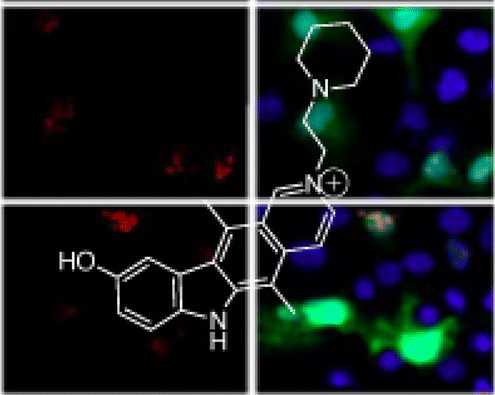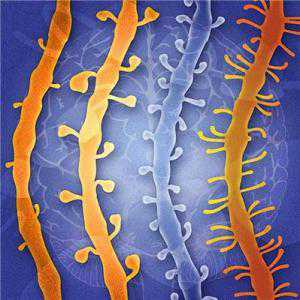ACS Chem Biol :治疗脆性X染色体综合征疾病的新型分子
2012-09-10 T.Shen 生物谷
近日,来自斯克利普斯研究所佛罗里达分校的研究者开发设计出了一种新型化合物,其可以作为一种新型潜在的疗法来治疗和脆性X染色体综合征(fragile X syndrome)相关的某些疾病。脆性X染色体综合征是一种遗传性疾病,可以引发智力发育迟缓、不育、记忆力减退等病症。 这项研究刊登在了9月4日的国际杂志ACS Chemical Biology上,重点研究了震颤共济失调综合症(tremor atax

近日,来自斯克利普斯研究所佛罗里达分校的研究者开发设计出了一种新型化合物,其可以作为一种新型潜在的疗法来治疗和脆性X染色体综合征(fragile X syndrome)相关的某些疾病。脆性X染色体综合征是一种遗传性疾病,可以引发智力发育迟缓、不育、记忆力减退等病症。
这项研究刊登在了9月4日的国际杂志ACS Chemical Biology上,重点研究了震颤共济失调综合症(tremor ataxia syndrome),其通常可以影响50岁以上的男性,并致其表现出和帕金森疾病一样的病症,如震颤、失衡以及肌肉僵硬等。
脆性X染色体综合征、脆性X染色体综合征及其相关疾病,都是一种称为“扩展三联体重复”(expanded triplet repeat)的结构序列所引发的问题。相比正常遗传密码老说,扩展三联体重复是一系列的在遗传密码中进行的三核苷酸类许多次重复形式。位于脆性X综合征1基因的缺失可以引发严重的RNA加工问题。
尽管对于疾病我们有许多潜在的RNA靶点药物,但是没有人知道如何去识别发现新型的小分子物质来定位这些RNAs。因此,这篇报告中,研究者开发出了一种化合物,可以以正确的RNA为靶点来逆转脆性X染色体综合征所引发的效应。
在震颤共济失调综合症中,这种扩展三联体重复形式可以导致异常蛋白质的表达,从而对机体造成严重破坏,这种三联体重复实际上可以迫使正常蛋白质来调节RNA的剪接。新型的化合物不仅仅可以改善RNA的剪接过程,而且可以最小化地降低这种三联体重复的破坏能力。Disney博士表示,我们可以在细胞培养液中破坏这种重复相关的缺失,而且在相当高的浓度中,我们完全可以逆转这种效应,更重要的是,这种化合物对细胞是无毒的,但是我们需要进行前期测试来验证。
同时,2012年3月份,刊登在国际杂志Journal of the American Chemical Society上的一篇研究报告中,研究者也描述了一种小分子物质可以在人类细胞模型和动物疾病模型中抑制强直性肌营养不良1型RNA的缺失效应。研究者表示,我们很高兴开发出了以RNA为靶点的新型小分子,而且这或许可以演化为一种遗传方法来用于靶位任何和RNA相关的疾病,比如脆性X染色体综合征。
这种新型化合物可以帮助我们更好地理解这些三联体重复是如何引发脆性X染色体综合征的,而且可以帮助我们解决震颤共济失调的病症。相关研究成果由国立卫生研究院等机构提供支持。
编译自:Scientists Design Molecule That Reverses Some Fragile X Syndrome Defects

doi:10.1021/cb300135h
PMC:
PMID:
A Small Molecule That Targets r(CGG)exp and Improves Defects in Fragile X-Associated Tremor Ataxia Syndrome
Matthew D. Disney *†, Biao Liu †, Wang-Yong Yang †, Chantal Sellier §, Tuan Tran †‡, Nicolas Charlet-Berguerand §, and Jessica L. Childs-Disney †
The development of small molecule chemical probes or therapeutics that target RNA remains a significant challenge despite the great interest in such compounds. The most significant barrier to compound development is defining which chemical and RNA motif spaces interact specifically. Herein, we describe a bioactive small molecule probe that targets expanded r(CGG) repeats, or r(CGG)exp, that causes Fragile X-associated Tremor Ataxia Syndrome (FXTAS). The compound was identified by using information on the chemotypes and RNA motifs that interact. Specifically, 9-hydroxy-5,11-dimethyl-2-(2-(piperidin-1-yl)ethyl)-6H-pyrido[4,3-b]carbazol-2-ium binds the 5′CGG/3′GGC motifs in r(CGG)exp and disrupts a toxic r(CGG)exp-protein complex in vitro. Structure–activity relationship studies determined that the alkylated pyridyl and phenolic side chains are important chemotypes that drive molecular recognition of r(CGG)exp. Importantly, the compound is efficacious in FXTAS model cellular systems as evidenced by its ability to improve FXTAS-associated pre-mRNA splicing defects and to reduce the size and number of r(CGG)exp-containing nuclear foci. This approach may establish a general strategy to identify lead ligands that target RNA while also providing a chemical probe to dissect the varied mechanisms by which r(CGG)exp promotes toxicity.

doi:10.1021/ja210088v
PMC:
PMID:
Design of a Bioactive Small Molecule That Targets the Myotonic Dystrophy Type 1 RNA via an RNA Motif–Ligand Database and Chemical Similarity Searching
Raman Parkesh †#, Jessica L. Childs-Disney †#, Masayuki Nakamori ‡, Amit Kumar †, Eric Wang §, Thomas Wang §, Jason Hoskins ‡, Tuan Tran †, David Housman §, Charles A. Thornton ‡, and Matthew D. Disney *†
Myotonic dystrophy type 1 (DM1) is a triplet repeating disorder caused by expanded CTG repeats in the 3′-untranslated region of the dystrophia myotonica protein kinase (DMPK) gene. The transcribed repeats fold into an RNA hairpin with multiple copies of a 5′CUG/3′GUC motif that binds the RNA splicing regulator muscleblind-like 1 protein (MBNL1). Sequestration of MBNL1 by expanded r(CUG) repeats causes splicing defects in a subset of pre-mRNAs including the insulin receptor, the muscle-specific chloride ion channel, sarco(endo)plasmic reticulum Ca2+ ATPase 1, and cardiac troponin T. Based on these observations, the development of small-molecule ligands that target specifically expanded DM1 repeats could be of use as therapeutics. In the present study, chemical similarity searching was employed to improve the efficacy of pentamidine and Hoechst 33258 ligands that have been shown previously to target the DM1 triplet repeat. A series of in vitro inhibitors of the RNA–protein complex were identified with low micromolar IC50’s, which are >20-fold more potent than the query compounds. Importantly, a bis-benzimidazole identified from the Hoechst query improves DM1-associated pre-mRNA splicing defects in cell and mouse models of DM1 (when dosed with 1 mM and 100 mg/kg, respectively). Since Hoechst 33258 was identified as a DM1 binder through analysis of an RNA motif–ligand database, these studies suggest that lead ligands targeting RNA with improved biological activity can be identified by using a synergistic approach that combines analysis of known RNA–ligand interactions with chemical similarity searching.
本网站所有内容来源注明为“梅斯医学”或“MedSci原创”的文字、图片和音视频资料,版权均属于梅斯医学所有。非经授权,任何媒体、网站或个人不得转载,授权转载时须注明来源为“梅斯医学”。其它来源的文章系转载文章,或“梅斯号”自媒体发布的文章,仅系出于传递更多信息之目的,本站仅负责审核内容合规,其内容不代表本站立场,本站不负责内容的准确性和版权。如果存在侵权、或不希望被转载的媒体或个人可与我们联系,我们将立即进行删除处理。
在此留言









#Biol#
68
#Bio#
57
#X染色体#
61
#ACS#
51
#染色体#
75
#综合征#
58